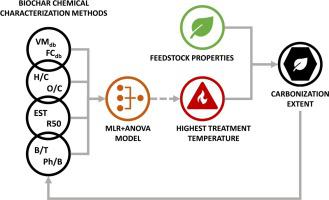当前位置:
X-MOL 学术
›
J. Anal. Appl. Pyrol.
›
论文详情
Our official English website, www.x-mol.net, welcomes your
feedback! (Note: you will need to create a separate account there.)
How to trace back an unknown production temperature of biochar from chemical characterization methods in a feedstock independent way
Journal of Analytical and Applied Pyrolysis ( IF 5.8 ) Pub Date : 2020-10-01 , DOI: 10.1016/j.jaap.2020.104926 Dilani Rathnayake , Przemyslaw Maziarka , Stef Ghysels , Ondřej Mašek , Saran Sohi , Frederik Ronsse
Journal of Analytical and Applied Pyrolysis ( IF 5.8 ) Pub Date : 2020-10-01 , DOI: 10.1016/j.jaap.2020.104926 Dilani Rathnayake , Przemyslaw Maziarka , Stef Ghysels , Ondřej Mašek , Saran Sohi , Frederik Ronsse

|
Abstract Besides the feedstock composition, the highest treatment temperature (HTT) in pyrolysis is one of the key production parameters. The latter determines the feedstock’s carbonization extent, which influences physicochemical properties of the resulting biochar, and in consequence its performance in industrial and agricultural applications. The actual HTT of biomass is difficult to measure in a reliable manner in many large-scale pyrolysis units (e.g., rotary kilns). Therefore, producers and end-users often rely on unreliable or biased information regarding this key production parameter that affects biochar quality. Data from indirect chemical assessment methods of biochar’s carbonization extent correlate well with the highest treatment temperature. Therefore, this study demonstrates that the HTT can be accurately assessed posteriori and feedstock-independently via a simple-to-use model based on biochar characteristics related to the carbonization extent. For that purpose, 24 contrasting biochars from 12 different feedstocks produced in the most common production temperature range of 350−700 °C were analysed using 5 different established biochar chemical characterization methods. Then, experimental data was used to establish a multilinear regression model capable of correlating the HTT, which was successfully validated for external datasets. The correlation accuracy for biochars of various origin (lignocellulosic, manure) was satisfactorily high (R2adj. = 0.853, RSME =47 °C). The obtained correlation proved that the HTT can be predicted feedstock independently with the use of basic input data. It also provides a quick, simple, and reliable tool to verify the HTT of a given biochar.
中文翻译:

如何以独立于原料的方式从化学表征方法追溯未知的生物炭生产温度
摘要 除了原料组成外,热解中的最高处理温度 (HTT) 是关键的生产参数之一。后者决定了原料的碳化程度,这会影响所得生物炭的理化性质,进而影响其在工业和农业应用中的性能。在许多大型热解装置(例如回转窑)中,很难以可靠的方式测量生物质的实际 HTT。因此,生产商和最终用户通常依赖有关影响生物炭质量的关键生产参数的不可靠或有偏见的信息。来自生物炭碳化程度的间接化学评估方法的数据与最高处理温度密切相关。所以,这项研究表明,可以通过基于与碳化程度相关的生物炭特征的简单易用模型,对 HTT 进行准确的后验评估,并且独立于原料。为此,使用 5 种不同的既定生物炭化学表征方法分析了在 350-700 °C 的最常见生产温度范围内生产的 12 种不同原料的 24 种对比生物炭。然后,使用实验数据建立能够关联 HTT 的多元线性回归模型,该模型已成功验证用于外部数据集。各种来源(木质纤维素、粪便)的生物炭的相关精度非常高(R2adj. = 0.853,RSME = 47 °C)。获得的相关性证明可以使用基本输入数据独立地预测 HTT 原料。
更新日期:2020-10-01
中文翻译:

如何以独立于原料的方式从化学表征方法追溯未知的生物炭生产温度
摘要 除了原料组成外,热解中的最高处理温度 (HTT) 是关键的生产参数之一。后者决定了原料的碳化程度,这会影响所得生物炭的理化性质,进而影响其在工业和农业应用中的性能。在许多大型热解装置(例如回转窑)中,很难以可靠的方式测量生物质的实际 HTT。因此,生产商和最终用户通常依赖有关影响生物炭质量的关键生产参数的不可靠或有偏见的信息。来自生物炭碳化程度的间接化学评估方法的数据与最高处理温度密切相关。所以,这项研究表明,可以通过基于与碳化程度相关的生物炭特征的简单易用模型,对 HTT 进行准确的后验评估,并且独立于原料。为此,使用 5 种不同的既定生物炭化学表征方法分析了在 350-700 °C 的最常见生产温度范围内生产的 12 种不同原料的 24 种对比生物炭。然后,使用实验数据建立能够关联 HTT 的多元线性回归模型,该模型已成功验证用于外部数据集。各种来源(木质纤维素、粪便)的生物炭的相关精度非常高(R2adj. = 0.853,RSME = 47 °C)。获得的相关性证明可以使用基本输入数据独立地预测 HTT 原料。











































 京公网安备 11010802027423号
京公网安备 11010802027423号